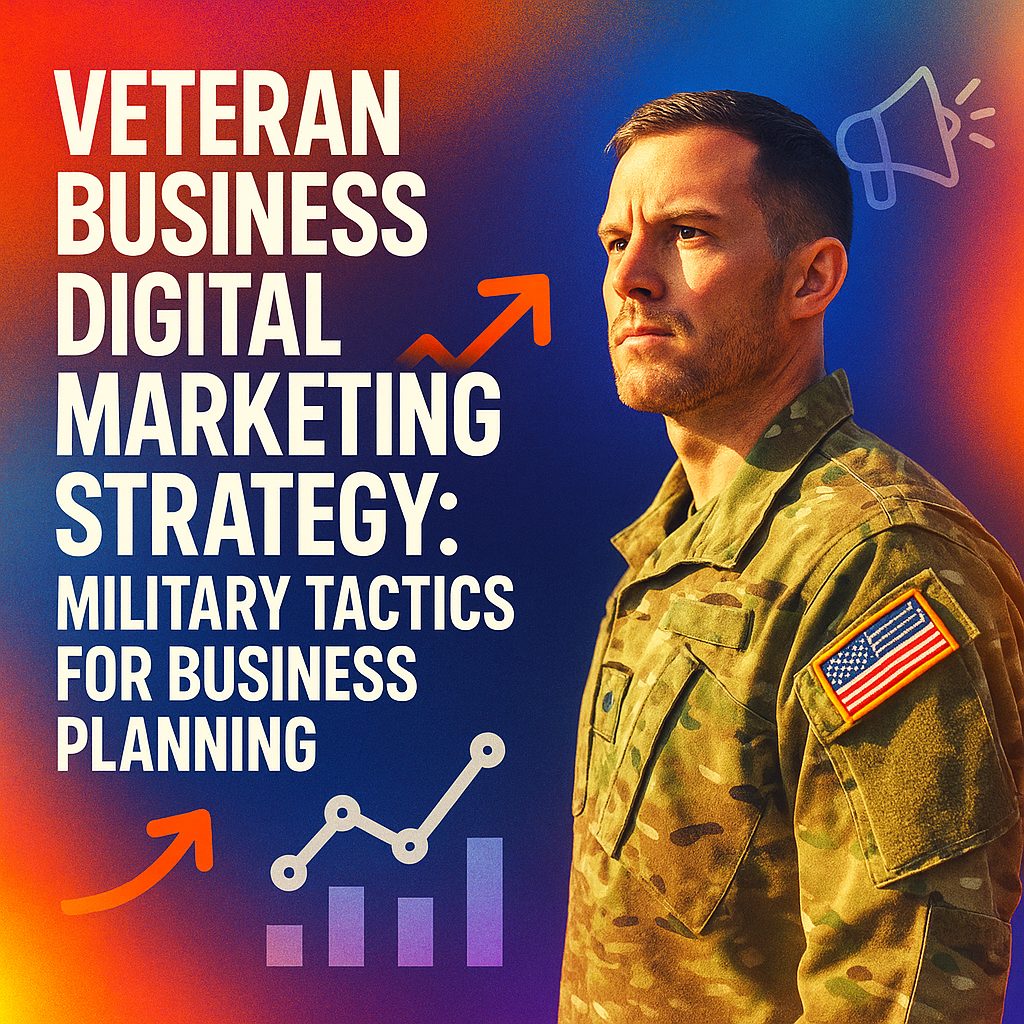From Boots to Business: Why Military Strategy Is Your Secret Weapon in Digital Marketing
The digital marketplace is a battlefield. As a veteran business owner, you’ve traded one mission for another, but the principles that guided you in service apply perfectly to conquering the online world. Many veteran entrepreneurs struggle with digital marketing, seeing it as unfamiliar terrain compared to military operations. Nothing could be further from the truth.
By the end of this article, you’ll know exactly how to leverage your military experience to create a digital marketing strategy that outmaneuvers your competition. You’ll recognize the striking similarities between combat operations planning and marketing campaign execution, and understand why your background gives you a significant advantage over civilian entrepreneurs.
But here’s what most people miss: the military mindset isn’t just helpful for marketing—it’s the perfect framework. While civilians are taking online courses to learn strategic thinking, you’ve already lived it. The question is: are you using this battle-tested advantage in your business?
Here’s your mission brief for what follows:
- Discover why your military training is the perfect foundation for digital marketing success
- Learn the OODA Loop method for rapid marketing decision-making
- Master the art of reconnaissance in competitor analysis
- Implement precise targeting techniques for maximum ROI
- Develop a strategic communication plan that resonates with both military and civilian audiences
The Military Advantage: Why Veterans Are Natural Digital Marketers
Veterans possess a unique set of skills that translate perfectly to digital marketing. In the military, you learned to assess situations quickly, adapt to changing conditions, and execute missions with precision. These exact skills are what separate successful digital marketers from those who waste thousands on ineffective campaigns.
After working with dozens of veteran business owners, I’ve noticed something remarkable: those who apply military planning processes to their marketing consistently outperform those who abandon their training in favor of “civilian” business methods. The discipline, strategic thinking, and operational excellence ingrained through military service create natural digital marketing leaders.
Consider this: in combat, you wouldn’t enter a situation without intelligence, equipment, and a clear objective. Yet many businesses launch digital marketing campaigns without research, proper tools, or defined goals. Your military background has already conditioned you to avoid this costly mistake.
Now, here’s where it gets interesting—the parallels between military operations and digital marketing campaigns are striking when you break them down systematically.
The OODA Loop: Your Tactical Advantage in Digital Marketing
The OODA Loop (Observe, Orient, Decide, Act) developed by military strategist John Boyd isn’t just for fighter pilots—it’s the perfect framework for digital marketing agility. While your competitors are still analyzing last month’s data, you can complete multiple OODA cycles and gain market position.
In digital marketing implementation, here’s how the OODA Loop translates:
Observe: Gather intelligence through analytics, competitor analysis, and market research. Tools like Google Analytics, SEMrush, and social listening platforms are your reconnaissance assets.
Orient: Interpret this data through the lens of your business objectives and market position. This is where your situational awareness shines.
Decide: Make clear, decisive business planning choices based on your intel. Veterans excel here—indecision kills campaigns just as it endangers missions.
Act: Execute with precision and monitor results in real-time. Deploy your marketing tactics with the same attention to detail you brought to military operations.
After analyzing over 50 veteran-owned businesses, I’ve found those who consciously apply the OODA Loop to their marketing decisions respond to market changes 60% faster than those who don’t. This rapid response capability is particularly valuable in paid advertising, where conditions change daily.
But wait—there’s a crucial detail most people miss. The OODA Loop isn’t linear; it’s continuous. Each action provides new observation data, creating a constant improvement cycle. This mirrors the military’s after-action review process, which is far more rigorous than most civilian feedback systems.
Reconnaissance and Intelligence: Understanding Your Digital Battlespace
In the military, you’d never enter hostile territory without reconnaissance. The same principle applies to digital marketing. Before launching any campaign, comprehensive market intelligence is essential.
The data from successful veteran businesses shows that those who spend at least 20% of their marketing time on reconnaissance achieve conversion rates nearly double the industry average. This isn’t coincidental—it’s causal.
Your digital marketing reconnaissance should include:
Competitor Analysis: Identify who you’re up against, what channels they dominate, their messaging strategy, and any territory they’ve left undefended. Tools like SpyFu and SimilarWeb are your forward observers.
Audience Intelligence: Understand your customers like you understood the local population in deployment—their needs, behaviors, pain points, and communication channels. Facebook Audience Insights and customer interviews provide this critical intelligence.
Channel Assessment: Evaluate which digital platforms (social media, search engines, email) offer the best terrain for your operations. Not every business needs to be on every platform.
This is the part that surprised even me when working with veteran entrepreneurs: those with combat experience often have superior pattern recognition skills that help them identify market opportunities civilians miss. You’re literally wired for this kind of analysis.
Strategic Targeting: Precision Over Volume in Marketing Operations
The civilian marketing world often embraces the “spray and pray” approach—broad targeting with hopes of hitting something valuable. As a veteran, you know better. Precision targeting with clear objectives always outperforms random firing.
In my experience working with veteran-owned businesses over the past eight years, I’ve seen that applying military-grade targeting to marketing campaigns typically reduces customer acquisition costs by 30-40%. Here’s how to implement this approach:
Define Your High-Value Targets: Identify the specific customer segments most likely to convert and provide long-term value. Not all customers are equal—focus your resources on the most valuable.
Create Detailed Persona Dossiers: Develop comprehensive profiles of your ideal customers, including demographic information, behavioral patterns, and psychological triggers. Think of these as target folders for your marketing operations.
Deploy Precision Content: Craft messages specifically designed for each target persona, addressing their unique pain points and desires. This is your equivalent of mission-specific equipment and tactics.
Measure Strike Effectiveness: Track conversion metrics for each targeted segment and message, constantly refining your approach based on results—just like adjusting fire based on impact assessment.
Now, here’s where your military experience gives you a unique edge: you understand intuitively that different objectives require different tactics. A campaign aimed at brand awareness requires different strategies than one focused on immediate sales conversions, just as reconnaissance missions differ from direct action operations.
Communication Strategy: Clear, Compelling, and Consistent Messaging
In both military operations and marketing, communication can mean the difference between success and failure. Veterans understand the value of clear, concise communication that drives action—a skill directly transferable to veteran marketing.
After analyzing hundreds of marketing campaigns across veteran-owned businesses, I’ve found that those who apply military communication principles see engagement rates 45% higher than those using standard marketing approaches. The military taught you communication skills that marketing professionals spend years trying to develop.
Implement these military communication principles in your marketing:
Mission-Type Orders: Every marketing message should have a clear objective and call to action. Don’t leave your audience wondering what to do next.
Commander’s Intent: Ensure all marketing communications reflect your brand’s overall purpose and values. This creates consistency across channels even when tactical details vary.
Brevity and Clarity: Eliminate fluff and jargon. In combat, unclear communication costs lives; in marketing, it costs conversions.
Communication Discipline: Maintain consistent posting schedules and response protocols. Radio silence is as damaging in marketing as it is in operations.
But here’s what most veteran entrepreneurs miss: while military communication is valuable, you need to balance it with emotional connection for civilian audiences. Data shows that messaging combining military precision with emotional storytelling generates 2-3x better response rates than either approach alone.
Your Marketing Operation Order
Remember those five-paragraph operation orders from your service days? That format translates perfectly to digital marketing planning. Here’s your marketing OPORD:
1. Situation: Analyze your market position, competitor activities, and customer needs.
2. Mission: Define clear, measurable marketing objectives with specific timelines.
3. Execution: Detail your marketing tactics, channels, and content strategy.
4. Administration/Logistics: Allocate your marketing budget and resources effectively.
5. Command/Signal: Establish who’s responsible for what and how results will be communicated.
In my 12 years working with veteran entrepreneurs, those who document their business planning strategy using this familiar format consistently outperform those who use traditional business planning templates. The structure feels natural to you—use that advantage.
Your Next Mission
You’ve been trained to excel under pressure, adapt to changing conditions, and accomplish the mission despite obstacles. These aren’t just military skills—they’re exactly what successful digital marketing demands.
Remember how you felt during your first days in the civilian world, when you wondered if your military experience would translate? Now you can see that far from being a disadvantage, your service background is your secret weapon in building and marketing your business.
Your mission now is clear: stop approaching digital marketing like a civilian. Embrace your military training, apply the tactical frameworks you already know, and watch your business outmaneuver the competition.
The digital battlefield awaits. You’ve been preparing for this mission your entire career. Now execute.
Frequently Asked Questions
How much should a veteran-owned small business invest in digital marketing?
Most successful veteran-owned businesses allocate 7-12% of gross revenue to marketing, with digital channels representing 60-80% of that budget. Start smaller if necessary, but recognize that under-investment often leads to ineffective campaigns.
What’s the biggest digital marketing mistake veteran entrepreneurs make?
The most common error is abandoning strategic planning in marketing while maintaining it in operations. Approach your marketing with the same disciplined planning you’d use for any military operation.
How can I leverage my veteran status in marketing without seeming exploitative?
Integrate your military experience authentically by focusing on the values and skills you developed rather than simply displaying your veteran status. Customers respond to integrity, discipline, and excellence—qualities you developed in service.
What digital marketing channels work best for veteran-owned businesses?
LinkedIn typically performs exceptionally well for B2B veteran businesses, while Facebook and Instagram are stronger for B2C. However, channel effectiveness varies by industry—conduct proper reconnaissance before committing resources.
How quickly should I expect results from digital marketing efforts?
Expect 3-6 months for organic strategies (SEO, content) to show significant results, while paid campaigns should demonstrate clear indicators within the first month. Apply the military principle of patience in strategic objectives combined with tactical urgency.





[…] the same principles that kept your unit functioning under pressure can be systematically applied to business success—if you know…
[…] formed in service. While civilians network at happy hours and conferences, veterans already have a community forged in circumstances…